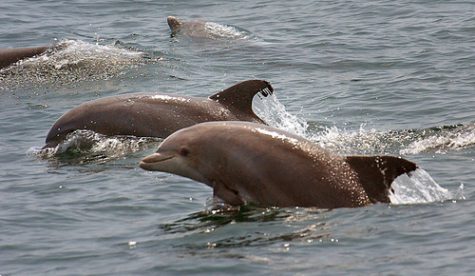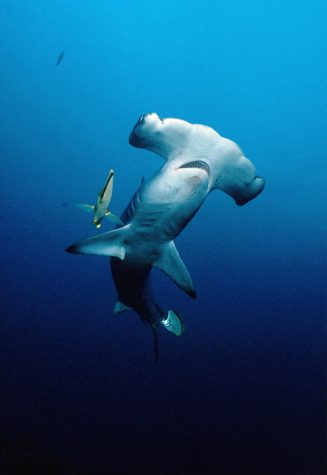Endangered Ocean Animals off our Coast
Many different types of animals, such as dolphins, hammerhead sharks, and sea turtles, live just off the shores of Huntington Beach. Today, these creatures are being negatively affected by different contributing factors: poachers, plastic, and nets, along with many of their habitats being destroyed. These animals, and countless others, are struggling more and more each year to survive.
One struggling ocean animal is the dolphin, an amazing creature with a surprisingly high IQ. They normally eat different types of fish and other ocean animals. Unfortunately, they also end up getting confused and consuming a lot of trash such as foam cups, paper bags, and the most common culprit, plastic. Perseus, a marine conservation website, says that up to 100,000 dolphins are killed each year due to eating plastic containers, lids, and bags. While we as humans understand that these day to day things are trash, sea creatures cannot tell the difference. Another man-made, deadly obstacle for dolphins are fishing nets. About 650,000 dolphins each year are killed or severely maimed for life after being caught by these nets, either on purpose or by ones that have been let go by fishermen who were discarding them as ‘trash.’ The Animal Welfare Institute states that, in addition to all of these obstacles and threats dolphins face daily, more than 100,000 dolphins are killed each year due to human poachers. Dolphins’ habitats are also rapidly decreasing due to coastal construction, climate change, and pollution, making it even more of a struggle for them to survive. A statistic from Aquatic Conservation Marine and Freshwater Ecosystems shows that the dolphin population has decreased between 39%-54% since the 1990’s. Dolphins desperately need human help; at this rate, they will be extinct in about 3 generations.

A fascinating species with a unique name and look is the hammerhead shark. They can grow up to 20 feet long and weigh up to 1,000 pounds. Their favorite snack is stingrays, which they often eat by pinning them down with their hammer-shaped heads. They like warm water all over the world, and while their habitats are not at risk, their population is decreasing rapidly. According to Brad Sewell, the senior director of the oceans division nature program, the population of hammerhead sharks is currently decreasing between 70%-80% in the United States annually. Brad Sewell also states that, since 2005, it is estimated their population has declined a total rate of 90%. Not to mention, the demand for shark fins is still growing rapidly due to them being considered a delicacy. Types of trash they tend to eat include cans, bottles, tires, coals, rags, and nails. While sometimes the trash they ingest has no effect on them, it can cause sickness. Hammerhead sharks are mostly endangered due to human’s environmental impact, which is why it is the people’s responsibility to help them.

Another at-risk animal is the sea turtle, which has been inhabiting the ocean for over 100 million years, helping keep a necessary balance between all the animals. They can be anywhere from 2-6 feet long depending on their age and species. They migrate around the ocean to open water, coasts, seagrass beds, and in and around reefs. They eat anything from jellyfish, crustaceans, to sponges. They also eat plastic bags, which look similar to jellyfish when in the water. The bag then gets stuck inside their stomachs causing blockage and later, death. They can get caught in plastic bags, plastic six-pack rings, and fishing nets. In addition, sea turtles continue to be poached for their eggs, meat, skin, and shells. It is estimated that 30,000 green sea turtles are poached each year just in Baja, California. Their habitats, such as coral reefs, are also being killed off due to trash pollution, which gives them yet another obstacle to overcome. A study done by the Endangered Species Coalition shows that one type of sea turtle, the leatherback, has declined 95% just in the Pacific nesting population over the past several decades. Sea turtles are fading, quickly at that, and if humans do not do something soon, the amazing creatures will vanish forever.

Ocean animals need our help before it is too late. There is nothing they can do to rectify the difficult environments we have forced (and continue to force) upon them. They are so important to our oceans and environment. It would be a terrible thing to sit back and let them die off. Once they are gone, they are gone. There is no way to bring them back to us; there is no second chance. You may have heard your parents say this to you when you were a little kid, and the same thing applies now: leave it how you found it, or leave it better than you found it. So, let’s all leave our ocean looking better than we found it. To get involved with ocean conservation and environmental efforts, consider joining the Green Team, the Orange County Earth Alliance, or the Endangered Species Awareness Association, all clubs at Huntington Beach High School.
Your donation will support the student journalists of Huntington Beach High School. Your contribution will allow us to cover our annual website hosting costs.
Thank you for supporting our program!






